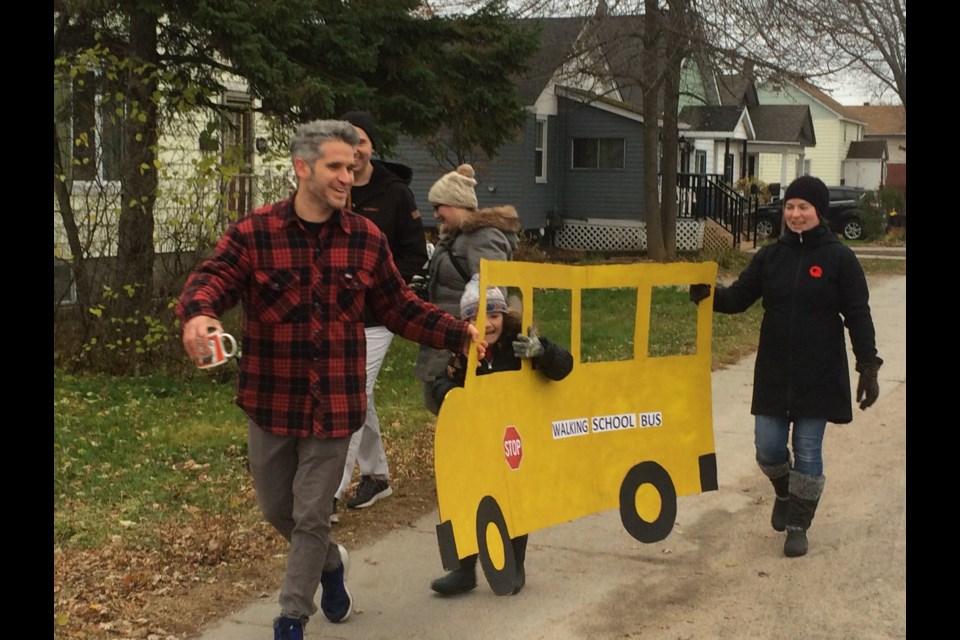A movement is afoot to increase the number of children walking to school, by encouraging families to increase their daily physical activity through active transportation.
On Friday morning, roughly 60 children, joined by parents and volunteers belonging to the Alliance French Immersion community, could be seen walking to school in groups creating a “walking school bus.”
The number of students represents about 10 percent of the school population.
The North Bay Parry Sound District Health United has received a one-time grant of $100,000 over a period of two years, from Ontario Active School Travel, a Green Communities program, to encourage children where possible, to walk, bike or scooter to school.
Often times students who could be walking to school, either take the bus or are driven to school in private vehicles.
“Over the last 25 to 30 years we’ve seen a really, really sharp decline in the percentage of children walking to school in Ontario, and in fact, across Canada. And what that has done is make a lot of school zones increasingly dangerous and congested,” said Wallace Beaton with the Ontario Active School Travel Program and Green Communities Canada
“Most of our school sites were never designed to accommodate that kind of traffic. So you’ve got a lot of schools, principals, teachers, and parents who are really concerned about the safety of the school environment for the kids. And children themselves are really concerned about the impacts in terms of air quality and pollution.”
Beaton was in North Bay to speak to students at Alliance about the Active School Travel Program.
He would like to see a return to the days when children were physically active the minute they stepped out the door.
“Kids are missing out on that basic bit of physical activity in the morning that most of us got as children. It makes them happier, it makes them healthier, it helps them in school. So we’re trying to re-establish that culture of walking and wheeling to school, make it the norm again as it was in the past.”
The grant money will not only support initiatives like the walking school bus but will assist in promoting special events at schools, in addition to developing action plans at each of the schools.
Parents will be asked to identify what some of the barriers are to walking and biking to school. That information will assist community partners, including the public health unit, to try and reduce some of those barriers, to make it easier and more convenient for families to choose active school travel, at least some of the time.
“We’re going to be doing active school planning, so we’re working with 10 schools to make a personal plan for those schools,” said Maxime Comeau community health promoter for the public health unit.
“We’re going to be collecting data from the students, to see how many students are walking or cycling to school. From the parents, we actually want to identify what the barriers are, that are stopping them from letting their kids walk to school. The data is going to be used so we can address whatever the issues are within the school plan.”
As an ex-physical education teacher and current principal of Alliance French Immersion, Brigitte Fiorino sees the over-all health benefits the program provides.
“It makes them happier when they get to school. They get the ‘sillies’ out of their body. We want a route where adults will show the kids how to cross the street, look both ways, wait for the green light, and guide the kids on how to eventually do this on their own,” said Fiorino.
“We already have a walking school bus up and running right now. It started a few weeks ago, a little later than expected because the biggest challenge is getting volunteers. They need to get a criminal record check done, and make sure that they’re available.”
The idea is to have one volunteer responsible for walking with an average of six children.
Parent volunteer Connie Hergott explains that volunteers are required to go through a brief training session, provide a criminal record check, and help map out routes that are appropriate to the school.
“Volunteer recruitment and volunteer retention is the biggest challenge,” said Hergott.
“People have busy lives and work days, but they still want to have their children walk to school, so we’re really struggling to get volunteers. In fact, I turn kids away from the walking school bus because I don’t have enough adult volunteers to meet the demand. Finding people that have a connection to the school community that is invested is the hard part.”
While the program is limited to the fall and spring to ensure success, Hergott says there is nothing to say it can’t be extended to include the winter months.
Parent Scott Robertson fully supports the program.
“I think it is absolutely fantastic. I personally am an active commuter and I know it helps me activate my body and activate my mind in the morning. It gives me some time to get myself ready for the day, and I think that applies to children as well. I think they will see a difference in their day from having walked to school, seeing their friends, getting some fresh air, activating their minds and bodies. I think it is fantastic,” said Robertson.
“For us, it is a 10-minute walk. My son enjoys it. He loves being outside and he loves exercising his body, and those are the kinds of values that we’re trying to instill at a young age, and I think he is responding really well to it.”
Mike Bissett sees the program as an opportunity to spend more quality time with his child.
“Being more physically active at a younger age is important. And also I got to spend a little more time with him. This gave us another 15 minutes or so before the day starts to get hectic, so that was nice.”



